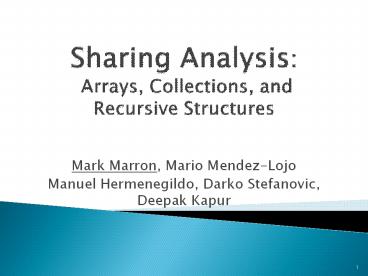Sharing Analysis: Arrays, Collections, and Recursive Structures - PowerPoint PPT Presentation
Title:
Sharing Analysis: Arrays, Collections, and Recursive Structures
Description:
Mark Marron, Mario Mendez-Lojo. Manuel Hermenegildo, Darko Stefanovic, Deepak Kapur ... (shape) analysis available at: www.cs.unm.edu/~marron/software.html. 22 ... – PowerPoint PPT presentation
Number of Views:56
Avg rating:3.0/5.0
Title: Sharing Analysis: Arrays, Collections, and Recursive Structures
1
Sharing Analysis Arrays, Collections, and
Recursive Structures
- Mark Marron, Mario Mendez-Lojo
- Manuel Hermenegildo, Darko Stefanovic, Deepak
Kapur
2
Motivation
- Want to optimize object-oriented programs which
make use of pointer rich structures - In an Array or Collection (e.g. java.util.List)
are there any elements that appear multiple
times? - Differentiate structures like compiler AST
with/without interned symbols --- backbone is
tree with shared symbol objects or a pure tree
3
Motivation Cont.
- Ability to answer these sharing questions enables
application of many classic optimizations - Thread Level Parallelization
- Redundancy Elimination
- Object co-location
- Vectorization, Loop Unroll Schedule
4
Solution
- Start with classic Abstract Heap Graph Model and
add additional instrumentation relations - Nodes represent sets of objects (or recursive
data structures), edges represent sets of
pointers - Has natural representation for data structures
and connectivity properties - Naturally groups related sets of pointers
- Efficient to work with
- Augment edges, which represent sets of pointers
with additional information on the sharing
relations between the pointers
5
Example Abstract Heap Graph
6
Concrete Sharing
- Region of the heap (O, P, Pc)
- O is a set of objects
- P is the set of the pointers between them
- Pc the references that enter/exit the region
- Given references r1, r2 in Pc pointing to objects
o1, o2 respectively we say - alias o1 o2
- related o1 ! o2 but in same weakly-connected
component - unrelated o1 and o2 in different
weakly-connected components
7
Sharing Alias and Unrelated
8
Sharing Related
9
Abstract Representation
- Edges abstract sets of references (variable
references or pointers) - Introduce 2 related abstract properties to model
sharing - Interference Does a single edge (which
abstracts possible many references) abstract only
references with disjoint targets or do some of
these references alias/related? - Connectivity Do two edges abstract sets of
references with disjoint targets or do some of
these references alias/related?
10
Interference
- For a single edge how are the targets of the
references it abstracts related - Edge e is
- non-interfering all pairs of references r1, r2
in ?(e) must be unrelated (there are none that
alias or are related). - interfering all pairs of references r1, r2 in
?(e), may either be unrelated or related (there
are none that alias). - share all pairs of references r1, r2 in ?(e),
may be aliasing, unrelated or related.
11
Interference Example
12
Connectivity
- For two different edges how are the targets of
the references they abstract related - Edges e1, e2 are
- disjoint all pairs of references r1 in ?(e1), r2
in ?(e2) are unrelated (there are none that alias
or are related). - connected all pairs of references r1 in ?(e1),
r2 in ?(e2) may either be unrelated or related
(there are none that alias). - share all pairs of references r1 in ?(e1), r2 in
?(e2) may be aliasing, unrelated or related.
13
Connectivity Example
14
Case Study BH (Barnes-Hut)
- N-Body Simulation in 3-dimensions
- Uses Fast Multi-Pole method with space
decomposition tree - For nearby bodies use naive n2 algorithm
- For distant bodies compute center of mass of many
bodies and treat as single point mass - Dynamically Updates Space Decomposition Tree to
Account for Body Motion - Has not been successfully analyzed with other
existing shape analysis methods
15
(No Transcript)
16
BH Optimizations Memory
- Inline Double into MathVector objects, 23
serial speedup 37 memory use reduction
17
BH Optimizations TLP
- TLP update loop over bodyTabRev, factor 3.09
speedup on quad-core machine
18
General TLP Results
19
Benchmark Analysis Statistics
20
Conclusions
- Presented a practical abstraction for modeling
sharing in programs - Allows us to accurately model how objects are
stored arrays (or Collections from java.util) - This information can be usefully applied to
compiler optimizations - Thread-Level Parallelization
- Vectorization or Loop Unrolling
- Various memory locality optimizations
21
Demo of the (shape) analysis available
at www.cs.unm.edu/marron/software.html
22
(No Transcript)































